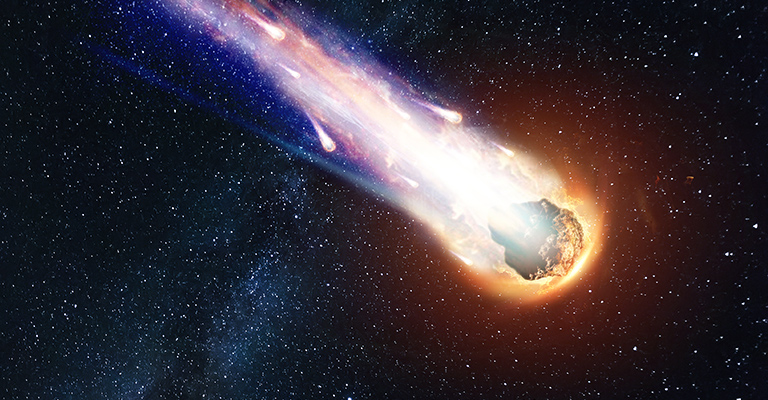“The asteroid is around seven miles across, bigger than Mount Everest,” Sir David Attenborough expounds.
“And travelling at close to 45,000 miles per hour. The impact causes an explosion bigger than a billion Hiroshima atomic bombs!”
Attenborough, the naturalist, broadcaster and (of course) national treasure, is describing, as part of jaw-dropping new BBC documentary Dinosaurs: The Final Day with David Attenborough, the mass extinction event that would bring death to the dinosaurs – and a brutal, abrupt end to their 165-million-year reign on Earth.
But how can he – and we – talk with such certainty about an event that happened 66 million years ago?
Well, as the documentary explains, it’s all thanks to the seismic findings of a team led by a University of Manchester palaeontologist…

The missing piece
“This is the most incredible thing that we could possibly imagine here, the best case scenario,” declares Robert DePalma, the man leading excavation work – for the past decade – at a top secret dig site in North Dakota.
“The one thing that we always wanted to find in this site, and here we’ve got it!”
Robert is describing the heart-pounding, caught-on-camera moment that he and his team discover the first-ever fossil of a dinosaur killed, apparently, by the asteroid impact.
The remarkable finding – the incredibly well-preserved leg of a small, herbivorous dinosaur called a Thescelosaurus – represents a vital clue as the team piece together the elaborate puzzle of what happened that fateful day.
Robert explains: “Dinosaur fossils are not known from the last years of the Cretaceous. And it was unclear whether they were already extinct or in decline, or what was going on. So they were just sort of absent.
“And this answers that question. Were dinosaurs still there then? Well, yes – this one likely died in that surge.”
Digging for treasure
It’s a dizzying find – and isn’t the only discovery at the site (part of the famous Hell Creek Formation and named Tanis, after the real-life ancient Egyptian city referenced in Raiders of the Lost Ark). Far from it.
In fact, the site has been described as a ‘treasure trove’ of geological records; each find providing important evidence of what life was like before the cataclysmic event.
Take, for example, the extremely rare unearthing of fossilised Triceratops skin, immaculately preserved and turned, over millions of years, into stone. The “closest thing to getting to touch a living, breathing dinosaur”, the team excitedly agrees.
Or the discovery of a super-rare pterosaur egg – complete with the fossilised bones of a baby pterosaur within.
Along with palaeobiologist – and University of Manchester Research Fellow – Dr Victoria Egerton, Robert uses the Diamond Light Source synchrotron in Oxfordshire, capable of creating beams of light many times brighter than the sun, to learn more about the chemical makeup of the egg.
They discover it was likely soft, more similar to a turtle’s egg than a chicken’s – much different to the hard shells typically (as far as we know) laid by dinosaurs.

Smoking gun?
At the Diamond Light Source Robert is joined by another Manchester academic, Professor Phil Manning of the Department of Earth and Environmental Sciences, this time to investigate wondrous ejecta spherules, preserved in amber and found at Tanis.
These spherules are created when asteroids crash into Earth; small droplets of molten and vaporised rock that shoot towards space before cooling, solidifying, and falling back to Earth.
Importantly, they can help link the site of the asteroid crash believed to have killed the dinosaurs – the Chicxulub crater beneath the Yucatán Peninsula in Mexico – and Tanis, some 3,000 kilometres away.
The synchrotron scan appears to reveal something amazing, and quite unexpected: a piece of the Chicxulub asteroid itself.
Or, as Professor Manning describes: “A piece of the bullet that killed the dinosaurs.”
Window to the past
The documentary is a wonderful snapshot of the incredible work taking place at Tanis, and an example of just some of the astonishing work led by Manchester experts in this field.
In a previous episode of The Buzz: A science and engineering podcast, we caught up with Professor Manning and Dr Egerton about another remarkable dig site – this one a secret location in Wyoming.
The Mission Jurassic project offers a unique window to the past, and the stunning finds include dinosaur skeletons, footprints and fossilised plants. It’s an ongoing project and, as Professor Manning told the BBC: “There’s probably enough dinosaur material here to keep a thousand palaeontologists happy for a thousand years.”
Indeed, be sure to keep an eye out for an upcoming episode of The Buzz podcast, where we once again catch up with Professor Manning to hear more about the extraordinary finds at Tanis and Wyoming.
Two spectacular sites – where Manchester researchers are dusting off breathtaking portals, revealing the past like never before.
If you enjoyed this post, be sure to subscribe on our homepage to keep up to date with the latest posts from The Hub.
Words: Joe Shervin
Images: Shutterstock, BBC
